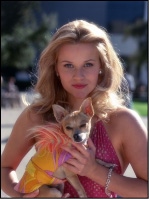|

Legally Blonde, by David Papke
David Papke is a law professor
at the Indiana University School of Law in Indianapolis, and
Virginia Papke, his daughter, is an eighth-grader at St. Richard's
School in Indianapolis. They enjoy going to the movies together,
but they do not always reach the same conclusions about what
they've seen . . . .
 David:
Did you enjoy Legally Blonde? David:
Did you enjoy Legally Blonde?
Virginia: It was cool.
David: What did you like about
it?
Virginia: Elle Wood. I liked
the way she looked, the way she dressed, the way she was so happy
and up-beat. I even liked her dog Bruiser. That mutt was hilarious!
David: The movie is one of
those law-related movies I like to write and think about. It
has some interesting things to say regarding the law.
Virginia: Pulease. This is
a chick flick if ever there was one. It's about a young woman
who shows up the jerk who dumped her and then gets a new and
better boyfriend. Almost everybody in the theater was a girl.
I went because I'm blonde and wanted to see a movie about a girl
who is blonde.
David: But Elle Wood goes to
law school and learns to think like a lawyer. There were some
great scenes of classrooms, study groups, and faculty conferences
at Harvard Law School. Modern legal education started at Harvard
in the 1870s, and many of us in legal academics still think of
Harvard as the symbolic home of legal education.
Virginia: That's not really
Harvard Law School. It's not serious. It's not a real-life picture.
You yourself showed me the letters from the Harvard students
in USA TODAY saying how silly the portrait of Harvard was.
David: Okay, but there's also
a trial. Elle Wood succeeds as a defense counsel in the courtroom,
in the inner sanctum of the law. Almost all law movies have dramatic,
powerful courtroom scenes. Americans find messages of morality
and justice in dramatic courtroom proceedings.
Virginia: Dad, it's a Hollywood
movie. It's all made-up. The courtroom's only a coincidence.
It might just as well have been a proceeding in a video arcade.
The courtroom is just a setting to show off Elle Wood's clothes
and make-up and let us know how cute and lovable she is. How
does she win her case? She tells everybody what you can do after
getting a perm. Was that about law and justice?
David: I guess different people
can see the same movie in different ways. There's even a theory
about this called reader response or reader reaction theory.
According to the theory, a movie is not just a container into
which writers and directors pour meanings which will later be
drained by the people who see the movie. Instead, individual
viewers bring their own values, tastes and histories to a movie,
and they respond or react to the movie in different ways. Variable
meanings then result from the multiplicity of movie-viewer interactions.
Virginia: What if I said Legally
Blonde was a cowboy movie?
David: It's not like anything
goes. There are boundaries for the possible meanings. You can't
argue that law students are cowboys. There has to be something
in a movie that would justify a viewer interpreting it in a given
way.
Virginia: And I can't see counting
Legally Blonde as a law movie. It's a chick flick, and
I'm glad that it is.
David: Are you too old for
a time out?
Posted October 2, 2001
|